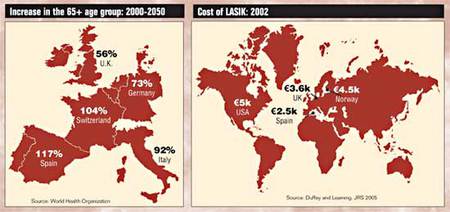In Europe, LASIK most cost-effective ametropia correction method
In the long term, LASIK may be more affordable than contact lenses or spectacles, survey shows.
ALICANTE, Spain – LASIK has become the most cost-effective way of correcting refractive errors in Europe within the past 3 years, according to a survey presented by one speaker here.
Cost of LASIK per eye
Source: Patel S |
“With the increase in competition within the refractive surgery market, prices have dropped,” Sudi Patel, PhD, FCOptom said. “A further decrease has been made possible by the reduction in the cost of laser technology and servicing, and last but not least, by the improved reliability of microkeratomes and lasers,” he said at the Alicante Refractive International meeting.
Currently, the average cost of a LASIK operation varies from about €600 to €1,000 per eye (US$700 to $1,200) in Norway, to €1,200 to €3,000 (US$1,500 to $3,600) in the United Kingdom and €2,500 (US$3,000) in Spain.
Taking into account the follow-up visits and lifelong yearly examinations, in the long term, the only competition LASIK has is with glasses, while contact lenses are far more expensive,” Dr. Patel said.
Long term eye care
The cost analysis made by Dr. Patel covered a 60-year period, from age 20 to age 80 years, in which the average ametropic patient incurs expenses for eye care according to the way he or she has chosen to correct refractive error. Additional events such as cataract surgery or glaucoma that may occur during a patient’s lifespan were excluded, because they have an equal impact on all categories independent of the correction adopted.
“With the aging of the population, the problem of long-term eye care of ametropic people on a global level will increase and have an impact on our economies,” Dr. Patel said. “Calculating which is the best and most cost-effective way of treating these patients is important not only from an individual but also from a societal point of view. And from this calculation, with the changes that have intervened in the past few years, we might have a few interesting surprises.

LASIK least expensive
Looking at the cost of spectacles in the United Kingdom, Dr. Patel included spectacles changed every 2 years, annual visits and eye examinations every 2 years, resulting in a total cost of €7,300 (US$8,900). In comparison, rigid contact lenses changed every 2 years, including costs of solutions, tests and yearly visits, was double the price, while daily disposable contact lenses totalled €26,000 (US$31,000) within the same period.
In comparison, LASIK is a much cheaper procedure. Taking into account the additional costs of glasses for driving and, of course, the yearly visits and eye examinations, the final cost in 60 years is €8,600 (US$10,500), Dr. Patel said. In the best cases, where only reading glasses are required over the age of 60, the cost drops to €6,700 (US$8,100), which is even lower than the cost of spectacles.
LASIK can become a more expensive procedure if complications such as mixed or irregular astigmatism occurs, he said. In this case, if rigid contact lenses are required, the cost increases to approximately €17,000 (US$20,700).
In the past, surgery required an initial investment that not all patients could afford, compared with spectacles or contact lenses with costs fractioned in smaller amounts over a long period, Dr. Patel said.
However, he added, “In some countries in Europe, like in the U.K., there are now financial schemes that offer the possibility to pay refractive surgery in monthly installments.”
Refractive surgery, once regarded as the Rolls Royce of refractive correction, has now become much more affordable and, it seems, the best long-term investment, he said.
A change of mentality
These survey findings have the potential to produce revolutionary change in the mentality of patients and in the distribution of refractive surgery in Europe, Dr. Patel said.
“So far, refractive surgery has spread more in Mediterranean countries than in the North of Europe, because in these areas people are more interested in cosmetic surgery in general. Recent statistical projections indicated that refractive surgery will not penetrate more than 5% of the eye care market in the U.K., while it will gain significantly in the South of Europe,” Dr. Patel said.
However, now that LASIK has become the affordable option, more patients further north may also be inclined to make it their first choice, he said.
For Your Information:
- Sudi Patel, PhD, FCOptom, is an optometric adviser for the National Health Service in Scotland. He can be reached at +44-131-276-6658; e-mail: Sudhir.Patel@psd.csa.scot.nhs.uk.
- Michela Cimberle is an OSN Correspondent based in Treviso, Italy, who covers all aspects of ophthalmology. She focuses geographically on Europe.
